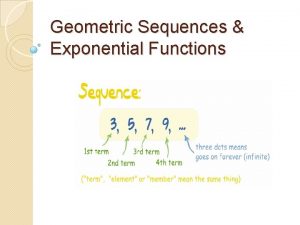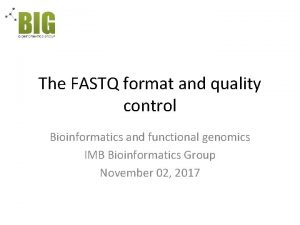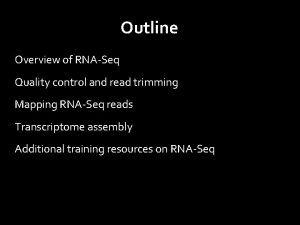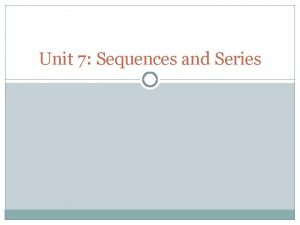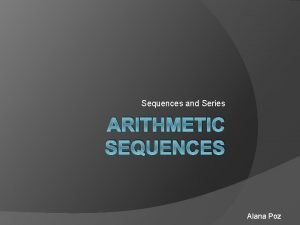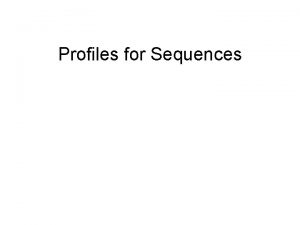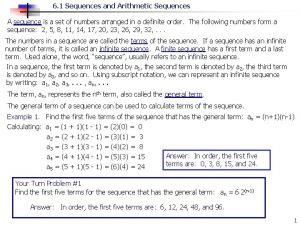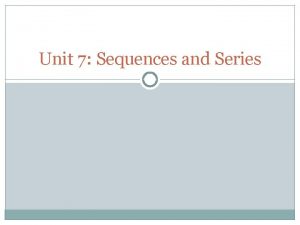Sequence Quality Assessment Quality Assessment of Sequences Why














- Slides: 14

Sequence Quality Assessment

Quality Assessment of Sequences • Why does quality assessment matter? – DNA -> Data = lots of processes => Errors can be introduced – Poor understanding of the data => Poor Assembly 2

Sources of problems • • Data corruption Unexpected data Missing data Too little sequence data Too much sequence data Contamination Duplication

Data corruption • Occurs: – Process failure ( software / hardware crash ) – Incorrect processing • Integrity: – Checksums – Format validation – Metadata analysis

Checksums • Checksums ensure data are consistent. – MD 5 • $ md 5 sum file 1. fastq. gz # before 823 fc 8 b 0 ca 72 c 6 e 9 bd 8 c 5 dcb 0 a 66 ce 9 b file 1. fastq. gz • $ md 5 sum -c checksums. md 5 # after file 1. fastq. gz: OK file 2. fastq. gz: OK file 3. fastq. gz: FAILED md 5 sum: WARNING: 1 of 3 computed checksums did NOT match – Calculate file checksums before transfer. – Verify checksums against the transferred files after the transfer.

Format Validation • Understand common file formats – Fastq – Fasta – SAM/BAM – HDF 5 ( and Fast 5 ) – GFA • Understand the meta data. – Description: https: //github. com/NBISweden/workshopgenome_assembly/wiki

Depth of Coverage • The number of times each base in the genome is covered by a read.

Depth of Coverage • What depth of coverage do I want? – Illumina: 50 x ~ 150 x – Pac. Bio: 15 x ~ 50 x (15 x > 10 kbp) – Oxford Nanopore: 15 x ~ 50 x (15 x > 10 kbp) – 10 X Genomics: 38 x - 56 x • What is my expected genome size? • Coverage = Number of bases sequenced / Estimated genome size

Calculating data quantity • Fast. QC / Multi. QC summary reports • Other third party tools • Command line calculation (my favourite way) – Can use Seqtk to convert files to fasta – zcat *. fastq. gz | seqtk seq -A [-L 10000] - | grep -v “^>” | tr -dc “ACGTNacgtn” | wc -m • • • zcat ( concatenates the compressed fastq files into one stream ) seqtk ( converts to fasta format [and drops reads less than 10 k] ) grep ( -v excludes lines starting with “>”, i. e. fasta headers ) tr ( -dc removes any characters not in set “ACGTNacgtn” ) wc ( -m counts characters )

Data quantity • Too little data: – More sequencing required. • Too much data: – Above 200 X coverage is considered extreme. – Increased computation time and resources. – Assemblies become more fragmented and inaccurate.

Subsampling and Normalization • Short reads (easy): – Use a random fraction of the reads maintaining read pairing. • E. g. Use the same seed (-s) and give the fraction (0. 1) in Seqtk. seqtk sample -s 100 read 1. fq 0. 1 > sub 1. fq seqtk sample -s 100 read 2. fq 0. 1 > sub 2. fq – Normalize uneven coverage (e. g. bbnorm) • bbnorm. sh in=read_1. fastq in 2=read_2. fastq out=normalized_1. fastq out 2=normalized_2. fastq target=100 min=5

Subsampling and Normalization http: //ivory. idyll. org/blog/what-is-diginorm. html

Subsampling and Normalization • Long reads (trickier): – Want longest reads for contiguity. – Want shortest reads for even coverage (consensus accuracy). – Canu can use weighted subsampling • read. Sampling. Coverage=1000 read. Sampling. Bias=0 • Initial coverage is high as subsequent processing reduces coverage.

Summary • Check your data is complete. – Checksums • Check your data is valid. – Format – Metadata • Check coverage. – More sequence? – Less sequence? • Subsample? • Normalize?
 Why why why why
Why why why why Nth term of exponential sequence
Nth term of exponential sequence Dont ask why why why
Dont ask why why why Amino acid nucleotide
Amino acid nucleotide Pseudocode selection
Pseudocode selection Finite series
Finite series Convolutional sequence to sequence learning.
Convolutional sequence to sequence learning. Per base sequence quality
Per base sequence quality Per base sequence quality
Per base sequence quality The condensation sequence theory explains why
The condensation sequence theory explains why Perform quality assurance
Perform quality assurance Quality management pmp
Quality management pmp Quality metrics pmp
Quality metrics pmp Define seminar in nursing management
Define seminar in nursing management Compliance vs quality
Compliance vs quality

